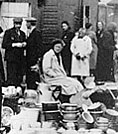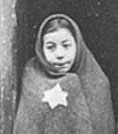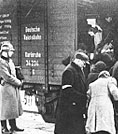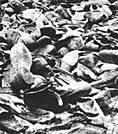 |
Ghettos
The Nazis
established ghettos
all across the occupied
countries from 1939 as a means to isolate the Jews
from the general population and therefore control them more
easily. They were usually established in the most run-down
areas of a city and surrounded by barbed wire, walls or guards.
The largest ghettos were in Poland.
 People
lived in overcrowded conditions and there were severe food
shortages leading to mass starvation. Jews were forced to
wear Yellow
Stars or badges for identification purposes. Jewish
councils called 'Judenrat' were established. They were appointed
by the Nazis to execute their orders within the ghettos. Refusal
to carry out their orders often meant death. The Jewish councils
helped to alleviate the suffering of the Jews as much as possible
by setting up soup kitchens, orphanages and hospitals. They
set up Nutrition, Health and Housing Departments. They were,
however, puppets to the Nazis. They had to supply fellow Jews
for deportation
to slave labour and to death camps. In Topic 2, Fela
Bernstein and Ruth
Foster talk about the acts of Jewish policemen, who
were controversial figures in the ghetto. People
lived in overcrowded conditions and there were severe food
shortages leading to mass starvation. Jews were forced to
wear Yellow
Stars or badges for identification purposes. Jewish
councils called 'Judenrat' were established. They were appointed
by the Nazis to execute their orders within the ghettos. Refusal
to carry out their orders often meant death. The Jewish councils
helped to alleviate the suffering of the Jews as much as possible
by setting up soup kitchens, orphanages and hospitals. They
set up Nutrition, Health and Housing Departments. They were,
however, puppets to the Nazis. They had to supply fellow Jews
for deportation
to slave labour and to death camps. In Topic 2, Fela
Bernstein and Ruth
Foster talk about the acts of Jewish policemen, who
were controversial figures in the ghetto.
 Approximately
1.5 million children died during the Holocaust. They were
often the most vulnerable of victims. In Topic 2, Ruth
Foster describes the decree by the Nazis to murder
an infant. In some ways, however, children were also very
strong as they developed unique tools to survive including
fantasy, creativity and play. Listen to survivor, Edith
Birkin, describing children singing songs, making
up plays and playing games in the ghetto. Approximately
1.5 million children died during the Holocaust. They were
often the most vulnerable of victims. In Topic 2, Ruth
Foster describes the decree by the Nazis to murder
an infant. In some ways, however, children were also very
strong as they developed unique tools to survive including
fantasy, creativity and play. Listen to survivor, Edith
Birkin, describing children singing songs, making
up plays and playing games in the ghetto.
Children
had to adapt to many role changes during the Holocaust.
They assumed adult responsibilities in the ghettos, they smuggled
food, contributed to family finances, cared for younger siblings
after the deportation of parents and even participated in
underground
activities. Thanks to their smuggling activities, the
ghetto Jews were saved from total starvation, as official
amounts of supplied rations were not enough to cover normal
requirements.
Deportation
Railways
were crucial to the killing process. Extermination camps were
deliberately positioned next to major railway lines in Poland.
Once ghettos were liquidated,
inhabitants were transported to camps in German-occupied Europe
by train.
 The
testimonies in Topic 2 clearly highlight the terrible journey
to the death camps. People of all ages were crowded into trains.
They had to endure long journeys with no sanitation, food
and space. In summer the heat and stench were suffocating,
whilst in the winter people froze. Thousands of people, including
large number of old and very young, died on these journeys.
Due to the immense weight of the people crowded into these
carriages the speed of travel was slowed to around 30mph,
thus prolonging the ordeal. The Jews were treated as freight
and most travelled in cattle wagons. There was little room
to sit down. Conditions were appalling, there was only one
bucket for human waste and another bucket for fresh water.
Journeys could take up to a week and many died on the way
to the camps. The
testimonies in Topic 2 clearly highlight the terrible journey
to the death camps. People of all ages were crowded into trains.
They had to endure long journeys with no sanitation, food
and space. In summer the heat and stench were suffocating,
whilst in the winter people froze. Thousands of people, including
large number of old and very young, died on these journeys.
Due to the immense weight of the people crowded into these
carriages the speed of travel was slowed to around 30mph,
thus prolonging the ordeal. The Jews were treated as freight
and most travelled in cattle wagons. There was little room
to sit down. Conditions were appalling, there was only one
bucket for human waste and another bucket for fresh water.
Journeys could take up to a week and many died on the way
to the camps.
The Nazis
or collaborating
local police forces generally ordered their victims to pack
some of their belongings, thus reinforcing the belief among
victims that they were being resettled in labour camps. The
Judenrat (Jewish Councils) in the Warsaw ghetto permitted
every deportee to carry 15kg of luggage, including cash, valuables
and provisions for three days. Some of the personal items
found in the piles of belongings confiscated by the Germans
include: Jewish religious items such as Sabbath
candlesticks, jewellery, razors, toothbrushes, money, writing
materials and cutlery.
 Hitler's
Final
Solution, where he planned to murder all the Jews,
was systematically organised. Six camps were built specifically
to kill the Jews of Europe. Not all concentration camps were
killing centres. Some served as hard labour camps whilst others
were transit camps. Before victims were gassed at the death
camps (Belzec, Sobibor, Treblinka, Chelmno, Majdanek and Auschwitz
-Birkenau), the SS
confiscated all personal belongings. Money and valuables were
taken first, followed by clothes. Even glasses, false teeth,
hair and artificial limbs were removed and placed in huge,
mountainous piles. Bones and ashes from the victims were also
utilised by the Nazis as fertiliser. The clothes and items
were distributed among German settlers in Poland and non-Jewish
inmates of other camps. The Final Solution produced over 2,000
freight carloads of stolen goods. Hitler's
Final
Solution, where he planned to murder all the Jews,
was systematically organised. Six camps were built specifically
to kill the Jews of Europe. Not all concentration camps were
killing centres. Some served as hard labour camps whilst others
were transit camps. Before victims were gassed at the death
camps (Belzec, Sobibor, Treblinka, Chelmno, Majdanek and Auschwitz
-Birkenau), the SS
confiscated all personal belongings. Money and valuables were
taken first, followed by clothes. Even glasses, false teeth,
hair and artificial limbs were removed and placed in huge,
mountainous piles. Bones and ashes from the victims were also
utilised by the Nazis as fertiliser. The clothes and items
were distributed among German settlers in Poland and non-Jewish
inmates of other camps. The Final Solution produced over 2,000
freight carloads of stolen goods.
Click
on the map button to see the location of the death camps.
|
 |